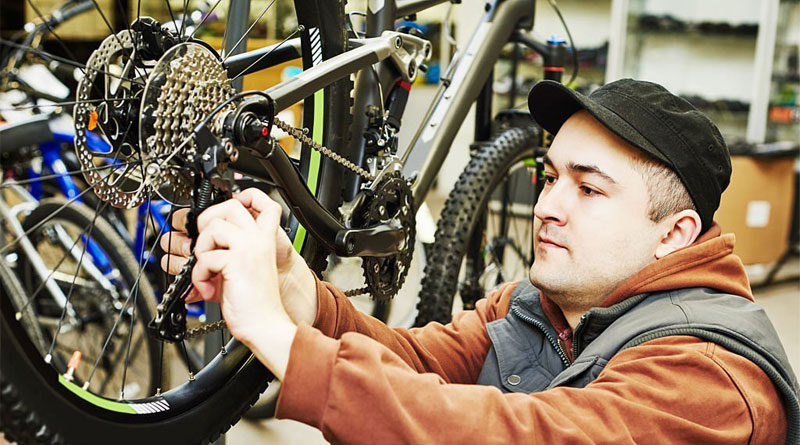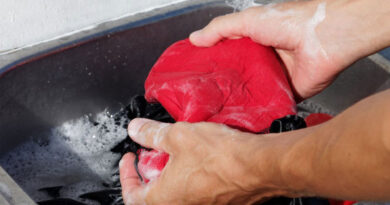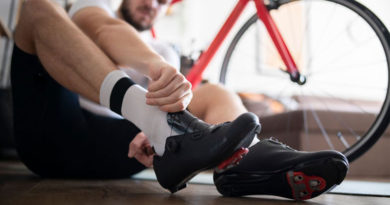How to Tighten a Bike Chain with a Derailleur?
Feeling that your bike chain is loose? It may be time to tighten the chain of your bike. But if you have a multi-gear bike, tightening the chain of your bike is not as straightforward as it is on a single-gear bike. The derailleur can seem intimidating and may make you wonder where it fits in adjusting the bike chain tension. To tighten the chain of your bike, you would need to understand what a derailleur is and how it works. This article will explain the procedure of tightening a bike chain with a derailleur.
What is a Derailleur?
A derailleur is a device that allows you to shift gears on your bike. Its role is to guide the chain onto larger or smaller sprockets when the tension in the chain is altered by the shifter. Derailleurs can be specifically made for specific bike types, for example, mountain bikes may have derailleurs specifically made for them. There are two types of derailleurs as mentioned below.
Front Derailleur
The working principle of a front derailleur is similar to that of a rear derailleur but it has fewer parts and a simpler structure. The front derailleur is located above the largest front sprocket. The benefit of a front derailleur is that you get double the gear ratios between the largest and the smallest gear.
Front derailleurs are optional. In fact, after the introduction of wide-range rear cassettes, front derailleurs are becoming less common. Wide-range rear cassettes provide the same range of gears but with fewer parts.
Rear Derailleur
A rear derailleur is located below the rear cassette. It is attached via a bracket to the bike and has two spring-loaded linkages known as the parallelogram. The parallelogram is connected to a cage consisting of an upper pulley and a lower pulley.
The upper pulley is known as the jockey pulley; it drives the chain into the sprockets. The lower pulley, known as the idler pulley, ensures that the chain is tight between the sprockets. The derailleur is connected via a cable to the lever on the gear shifters that are on the handlebars. The cable either becomes tight or loose whenever the lever is pressed.
Types of Rear Derailleurs
There are three types of rear derailleurs.
- Long Cage Derailleur: Have a chain range capacity of 44-43T. They are used for bikes with a wide gear range like 27-30 gear combinations. It ensures that the rider has enough options to select the right gear for a terrain. Long chain derailleurs can also support any chain tension regardless of the gear choice. But the chain may become loose and hit the frame. Long cage derailleurs are usually used for mounting bike riding and for cross-country competitions.
- Medium Cage Derailleur: Have a chain range capacity of 37-39T. Mostly used for mountain bikes. These derailleurs provide more ground clearance so the chain is less likely to hit rocks. However, they may be relatively loose.
- Short Cage Derailleur: Short cage derailleurs have a chain range capacity of 33T or less. They provide better tension and allow accurate and silent shifting of gears. They provide the most ground clearance. But the chain tension does not remain constant and has to be adjusted more frequently. Short derailleurs should not be used in bikes with a 27-gear ratio.
Tools Required to Tighten a Bike Chain
Following are the tools you may require to tighten the chain with a derailleur.
- Long nose pliers
- Pedal wrench or wrench
- Derailleur alignment gauge
- Screwdrivers
- Allen/hex wrench
Things to Know about a Derailleur
You need to know the functions of the following components of a derailleur to adjust it.
Limit Screws
A derailleur moves the chain up and down the sprockets in the bike’s cassette. The limit screws prevent the chain from falling off the largest or the smallest sprockets by telling the derailleur when to stop. Issues in shifting to the smallest and the largest sprocket or the chain falling off means you need to adjust the limit screws. There are two types of limit screws and bolts found at the back of the derailleur.
Low Limit
The low limit screw prevents the derailleur from moving towards the wheel of the bike. When properly adjusted, the low-limit screw allows the chain to sit in the largest sprocket without issues. It also prevents the chain from falling past the largest sprocket.
High Limit
The high-limit screw prevents the derailleur from moving away from the wheel towards the frame of the bike. It allows the chain to sit in the smallest sprocket and not fall onto the frame of the bike.
B Tension Screw
The B tension screw determines the angle of the derailleur body which in turn determines the tension on the bike chain. If the setting is off, you would have inaccurate shifts.
Barrel Adjuster
The barrel adjuster is used to control the cable tension. If there is too much tension in the cable, the gears will skip. If there is not enough tension in the cable, the gears won’t shift up.
How Tight Should the Bike Chain Be?
You should only be bothered with how tight your bike chain should be if you have a single-gear bike. The chain should neither be too tight nor too loose. A chain too tight would cause the teeth of the sprockets and the chainrings to wear out quickly. A chain too loose would not transfer the energy from the paddles to the wheel efficiently.
You can use a simple adjustable wrench or a fancy chain checker tool to adjust the tension of your bike chain. Generally, the chain should only be tight enough to allow you to move it from half an inch to an inch. The chain should come back into its place after it is moved.
In a multi-gear bike with a derailleur, the tension in your bike’s chain shouldn’t bother you. The springs in the derailleur keep the chain adequately tight. In fact, bike frames made to have a derailleur don’t even allow you to adjust the tension of your bike’s chain. You just have to adjust the derailleur properly to have adequate tension in the chain.
Steps to Tighten a Bike Chain with Derailleur
Here is a step-by-step guide to tightening a bike chain with a derailleur:
- Place the bike on a stand and make sure it is firmly placed. If you don’t have a bike stand, you can flip the bike upside down. Put something soft on the ground to protect the saddle and the handlebars.
- Shift the gears up and down to see if they shift correctly to the assigned gear. If the chain moves to a larger sprocket than indicated on the shifter, you need to decrease the tension in the cable. Turn the barrel adjuster clockwise to do so. If the chain moves to a smaller sprocket than indicated on the gear shifter, you need to increase the cable tension. Turn the barrel adjuster anti-clockwise to do so. Adjust the barrel adjuster until you get accurate shifts.
- Shift gears to move the chain to the largest sprocket. If the chain falls past the sprocket or doesn’t move to the largest sprocket, adjust the low-limit screw. It is labeled as “L” at the back of the derailleur.
- Now shift the chain to the smallest sprocket. If the chain falls past the smallest sprocket or fails to move to the smallest sprocket, you need to adjust the high-limit screw. It is labeled as “H” just above the low-limit screw at the back of the derailleur.
- Adjust the “B” tension screw to bring the jockey pulley within 3mm of the sprocket. Turn the screw clockwise to move the jockey wheel away from the sprocket and vice versa. If the jockey wheel is too close to the sprocket, the two will rub against each other. If the jockey wheel is too far away, you will have sloppy gear shifts. The B tension screw determines the tension in your bike chain. Adjusting this screw properly is essential to have a tight chain.
The derailleur should be inspected regularly. A derailleur adjusted properly shouldn’t make any noise. You should only need to adjust the cable tension on a derailleur which can be done with the barrel adjuster. If the derailleur is causing you more problems or making noise even after adjustment, it is time to change the derailleur. You should also go to a local bike shop to identify the problem and fix it.
Also, check for…
As you are tightening the bike chain with the derailleur, also check for the following things along the way:
Chain Wear
Chain wear is a natural process that happens with every ride. The rollers and pins holding the chain wear out. The process is sped up in adverse conditions. Riding with a worn-out chain can also cause the cassette teeth and derailleur pulleys to wear out quickly.
If you don’t replace the chain at the right time, you would have to replace the whole drivetrain which is a lot more expensive. Unexpected falling off the chain and generally rough shifts are a sign to check for chain wear. You can get yourself a chain checker tool to make the process easier.
Bent Derailleur Hanger
Bent derailleur hangers are more common than you think. The bike falling over or you or someone else crashing your bike can cause the derailleur to bend. You should also look for damage on the spokes or the derailleur in such a case.
The derailleur hanger is made of soft, malleable metal, hence, bends easily. Even a slight bend can cause shifting issues. Inspect the derailleur hanger to see if the alignment is out. A derailleur alignment gauge can make this process very easy with accurate readings. The tool can also help you bring the derailleur back to its original position. A hanger too bent to repair can only be replaced.
Damaged Cable or Housing
Check for a damaged cable or cable housing. They are another factor in problems related to gear shifts. The cable usually wears out at the point where it makes a bend into the derailleur and is secured with a bolt. You would need to replace the cable in such a case.
Check the housing of the cable at the front where it connects to the shift lever and at the back where the cable connects to the derailleur. Housing with an extreme bend or pinch can restrict the movement of the cable which, in turn, restricts the movement of the derailleur. Replace the housing in such a case.
Check the housing and the cable for any visible damage and replace the damaged parts. If your bike has internal cabling, you would have to work a lot harder to diagnose your cable issues. You may need to replace both, the cable and the housing, to diagnose the issue.
Final Thoughts
In a multi-gear bike, you use the derailleur to tighten the chain of your bike. The derailleur allows you to change gears in your bike. The B tension screw allows you to adjust the tension in your bike chain. But you would also have to adjust the limit screws and the barrel adjuster to ensure that the chain doesn’t fall off and you get accurate shifts. Along the process, you can also check for chain wear, damaged cable or cable housing, and bent derailleur hangers. If the derailleur is adjusted properly, you wouldn’t have to worry about the tension in your bike’s chain. The springs in the derailleur would ensure adequate tension.




